This month, we’re doing daily reviews of the second season of Daredevil. Check back daily for the latest review.
And so we reach the end of the second season of Daredevil.
Except it is very clearly not the end. “This is not the end,” Elektra whispers as she lies dying in Matt’s arms. Although Elektra has hardly been the most honest or reliable character across the run of the season, she seems to be telling the truth. While the first season of Daredevil made a point to square away most of its characters and plot points at the end of the run, the second season consciously leaves things dangling. Nelson and Murdock has been dissolved. Elektra’s body has been stolen. The Hand are not defeated.

The dead only quickly decay…
The first season ended in a relatively tidy fashion, with only a few oblique hints towards what the future might hold. The most significant of these loose ends, Wilson Fisk being taken to a holding cell, was consciously put on the backburner when the second season began. Although the second season would pick up on that storythread, it would not do so until the cliffhanger of Guilty as Sin leading into Seven Minutes in Heaven. There was a sense that the audience could have left Matt Murdock there and been happy. At least until The Defenders.
The end of the second season is much more ambiguous. There is no sense that anything is being left anywhere for an extended period of time. Whether those dangling plot threads will be addressed in a hypothetical third season of Daredevil or during The Defenders, it is clear that audiences are being kept on a hook.

“John Luther and James Bond both recommended this, so I thought I’d be foolish not to give it go…”
To be fair, there is some indication that both Netflix and Marvel were surprised at the success of the first season of Daredevil. After all, the character was very much a second-tier Marvel character whose most recent impact on the pop cultural landscape had been a disastrous 2003 film starring Ben Affleck in a costume that the actor described as “a source of humiliation for him.” There had been talk about director Joe Carnahan doing a period trilogy of Daredevil movies at Sony, only to be thwarted when the rights reverted back to Marvel Studios.
Daredevil arrived at a point when “Netflix Originals” was still a relatively new brand. The company had made a major play to provide original content starting in 2013. That year saw three major releases; the real coup was luring director David Fincher and actor Kevin Spacey to their adaptation of House of Cards. Of the other releases that year, Orange is the New Black was a critical hit while Hemlock Grove was a definite miss. Things simmered for a little while.

“I am Daredevil… Did that sound a little too Christian Bale to you?”
2014 was relatively quiet when it came to original scripted content on Netflix. Bojack Horseman was a bold move from the streaming service, a surrealist animated comedy that seemed destined to find a cult audience and which has become a much-appreciated critical darling. When it came to more conventional original scripted programming, there was only one major dramatic “Netflix Original” premiering in 2014. Marco Polo started streaming from mid-December to a muted response.
So Daredevil was a relatively early addition to the Netflix stable. It arrived as the third in a three-pronged sweep, following The Unbreakable Kimmy Schmidt and Bloodlines. The Unbreakable Kimmy Schmidt had the pedigree of a Tina Fey production originally planned for NBC, and so it seemed almost an accident it ended up on Netflix. Bloodlines was released only two weeks before Daredevil, and simmered slowly in the background; Leonardo DiCaprio’s endorsement notwithstanding.
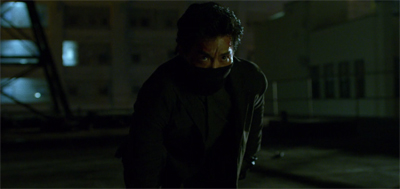
Ninja assassin.
However, the “Netflix Original” floodgates quickly opened over the following months and into 2016. Sense8, Narcos, Jessica Jones, Wet Hot American Summer: First Day of Camp, Master of None, w/ Bob and David, Love, Fuller House. Over the intervening years, some of the older Netflix series began to build up multiple seasons. It has been argued that 2015 saw Netflix become a legitimate television network in terms of content production. It is estimated that Netflix will release over six-hundred hours of original content in 2016.
All of this is to say that the second season of Daredevil exists in a very different context to its direct predecessor. There was every possibility that the first season of Daredevil could have failed. It seems highly likely that the original model for Netflix’s Marvel properties was going to be four shows running a single season each before launching The Defenders. Barring a cameo in Luke Cage or Iron Fist, it must have seemed quite likely that the next time that the audience would see Charlie Cox as Matt Murdock would be in The Defenders.
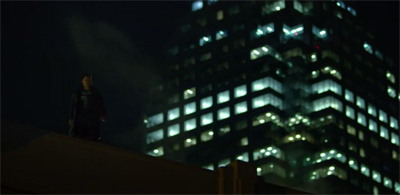
Welcome Back, Frank…
As a result, it seems like the production team made a conscious effort to tidy everything away at the end of the first season. It appears that Daredevil was intended to serve as some firm closure for Matthew Murdock and his supporting cast. The first season finalé allows most of its heroes a happy ending, putting them in a place where the audience would be willing to leave them for the couple of years it would take to cycle through all of the individual Defenders miniseries.
With that in mind, the success of that first season seemed to take everyone by surprise. A second season was announced within eleven days of the premiere, with Marvel and Netflix making a somewhat hasty adjustment to their production and release schedule in order to accommodate a sophomoric set of adventures for the Devil of Hell’s Kitchen. Showrunner Steven DeKnight had apparently not been signed for multiple seasons; he dropped out citing “previous commitments” that would subsequently be revealed to be the Transformers shared universe.
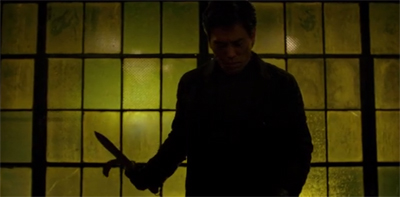
Nobu rest for the wicked…
Luke Cage was pushed back by six months so that Daredevil could occupy the Spring 2016 release slot. Given that Jessica Jones was already in production and scheduled, that was the earliest possible release slot for a second season. Daredevil was no longer a scrappy underdog property that was designed to headline a bunch of b- and c-list superhero misfits. Daredevil was a bona fides breakout hit for both Netflix and Marvel. In a way, it feels quite similar to the success Marvel had with Iron Man; a project which succeeded beyond the already ambitious expectations.
So, much like Iron Man, the sequel was rushed forward. While the projects still in the pipeline represented an unknown property and a bit of a gamble for Marvel and Netflix, projects like Daredevil and Iron Man had brand recognition that would stand to them. As a result, Iron Man II was produced and released almost immediately, leapfrogging Thor and Captain America: The First Avenger to give audiences more of the studio’s breakout character. The pattern is eerily familiar.
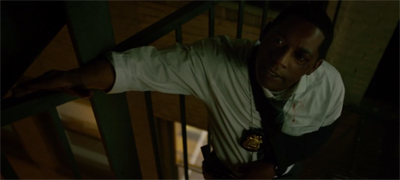
Safe Brett.
Indeed, there are any number of obvious parallels between Iron Man II and the second season of Daredevil. Both are somewhat bloated follow-ups to relatively simple projects. Both make a point to build outwards, developing supporting cast for the shared universe; while Black Widow is still waiting for her own film, rumours of a Punisher spinoff have begun to swirl. Both also make a point to integrate more fully with the shared universe, whether making more explicit dialogue references to other events or ending on an ambiguous note.
Iron Man II ended on the suggestion that Tony Stark might not be an ideal candidate for Nick Fury’s “Avengers Initiative”, which would have seemed to have been an obvious plot point for The Avengers but was quickly brushed aside. Then again, the transition from the “Phase I” films into The Avengers was far from graceful; the isolation of Asgard from Midgard with the destruction of the Rainbow Bridge had been a major cliffhanger from the end of Thor that was also quickly glossed over in The Avengers.

“Trust me, this is mint condition.”
The second season of Daredevil also ends with a number of obvious cliffhangers that require some resolution in the near future. Foggy and Matt have gone their separate ways, with Foggy joining another law firm in the city. Elektra was dead and buried, but the final moments of the season reveal that her grave has been exhumed and that the Hand are in possession of her body. The Punisher is still at large. These are plot points that firmly suggest a looming resolution, whether in a hypothetical third season of Daredevil or in The Defenders.
More than that, both Iron Man II and the second season of Daredevil arrive at a point where their shared fictional universe has a much stronger foundation. As such, the production teams are able to throw in more overt references to the events of this alternate world. Iron Man II explicitly acknowledges the presence of Captain America’s shield in dialogue, while Coulson disappears in the middle of the movie to deal with the events of Thor. These are a lot more explicit than a Samuel L. Jackson cameo in the middle of the closing credits.

I heard the news today, oh boy…
(It should be noted that the second season of Daredevil is the first of Marvel’s “Netflix Original” properties to hide a teaser for a future project in its closing credits. When queued up on Netflix, the closing credits of A Cold Day in Hell’s Kitchen segue smoothly into very short promo for Luke Cage. Neither the first season of Daredevil nor the first season of Jessica Jones featured a similar trailer, suggesting that the Netflix shows are moving closer and closer to the model established by the studio’s cinematic releases.)
Much like Iron Man II, the second season of Daredevil is tightly integrated into its own shared universe. While AKA Smile made reference to Matt Murdock when Claire Temple crossed between shows, the hero was never mentioned by name. In contrast, Marci explicitly drops the name of Jessica Jones into conversation with Foggy when they meet at the bar in Kinbaku. When Foggy goes for a job interview at the start of A Cold Day in Hell’s Kitchen, he is interviewed by Jeri Hogarth. The direction makes a big deal of Carrie Anne Moss’ cameo.
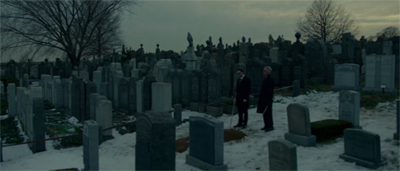
A grave disappointment…
More important is the context of these crossover appearances. Daredevil and Jessica Jones have been curiously ambiguous in their references to the shared universe. The Chitauri invasion served as a background detail for the first season of Daredevil, but was always ambiguously described as “the Incident.” This carries over into the second season, with Ellison using the description again in Semper Fidelis to account for why all the Bulletin’s records are kept in hard copy. Jessica Jones makes subtle nods to “the flag-waver” and “the big green guy.”
However, the second season of Daredevil gets less ambiguous about the world it inhabits. There are a number of none-too-subtle references to the looming conflict between Captain America and Iron Man in Captain America: Civil War. During the conversation where she name-drops Jessica Jones, Marci also implies that the establishing is growing increasingly uncomfortable with the existence of super-powered individuals. There is even an awkward reference shoe-horned into the ninja fight scene at the climax of A Cold Day in Hell’s Kitchen.

Look, I’m not one to tell the leader of a cult of undead ninja how to run his business, but should he really be meditating in front of a giant window during a hostage siege?
“What’s going on up there?” Foggy asks, as the situation escalates. Karen responds, “I think it might be the end of vigilantes in New York.” There are other rather blunt hints of a simmering tension seeded in A Cold Day in Hell’s Kitchen, with Detective Brett Mahoney making a point to stress how tired he is of vigilantes like Daredevil while Melvin Potter offers an equally random endorsement of the Devil of Hell’s Kitchen. These sentiments feel a little forced, as if they serve something other than the story being told.
To be fair, part of this might be down to issues with the climax of the episode. Put simply, A Cold Day in Hell’s Kitchen does not feel like an epic finalé. Matt and Elektra square off against a bunch of ninjas on a rooftop. That feels kinda like the action sequence you’d get fifteen minutes into Captain America film, rather than the conclusion to an entire season. More to the point, the second season of Daredevil has already produced a number of more impressive set pieces. Nothing in A Cold Day in Hell’s Kitchen can top the ninja brawl or boat explosion in .380.
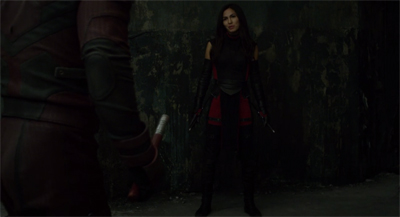
“Yeah, Melvin ran out of fabric when he was doing the shoulders. Still, you should see what Psylocke’s wearing.”
As such, it seems strange that Karen would point to a bunch of weird ninjas using bows and arrows while taking over a New York warehouse as “the end of vigilantes in New York.” It seems like very weird last straw. Even excluding the obvious Chitauri invasion, the Punisher’s killing spree in Bang and Dogs to a Gunfight would seem more credible as vigilante panic. These ninja are not randomly killing people. They have effectively forced a hostage situation. This is not a vigilante incident. Barring the zombie ninja, this is a fairly traditional terrorist attack.
Then again, this goes to demonstrate just how muddled the second season of Daredevil is; particularly in its final hours. One of the more interesting aspects of Daredevil, particularly compared to other Netflix shows, is its rigourous episodic structure. The show is not really a thirteen-hour movie, even if some more hardcore audiences might consume it as such. It is a very traditionally structured show, albeit one with a tight season structure due to the luxuries of the Netflix model. Individual episodes tend to serve a clear purpose and are relatively self-contained.
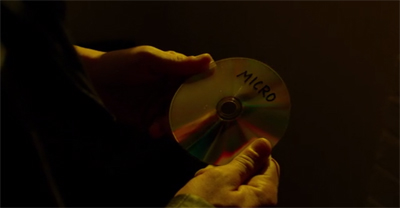
Let’s disc-uss this further!
This is a problem with A Cold Day in Hell’s Kitchen. In many respects, the season finalé would work a lot better if the writing staff had written it as a two-parter, more evenly spreading the load between The Dark at the End of the Tunnel and A Cold Day in Hell’s Kitchen. As with Daredevil at the end of the first season, this tight episode-by-episode approach to plotting leaves A Cold Day in Hell’s Kitchen with a phenomenal amount of heavy lifting. Not only does the episode have to set up and resolve its own plot, it has to also wrap up the season.
There is not enough time to get everything done properly. A Cold Day in Hell’s Kitchen feels like it has a laundry list instead of a plot. The Hand have to kidnap everybody that Daredevil has saved. They have to take them to a central location. They have to force a stand-off with the police. Daredevil has to find out about the abductions, figure out Karen is missing and catch up with them. There has to be a big fight scene, with Elektra redeeming herself. And all of this has to be wrapped up with ten minutes to spare to wrap up the season. Oh, don’t forget the Punisher.

Definitely don’t forget the Punisher.
Had the plot been broken down and split across The Dark at the End of the Tunnel, it might flow better. If A Cold Day in Hell’s Kitchen began with Matt releasing that the Hand had kidnapped all of the people he saved and preparing for a stand-off with Nobu, the writing staff would have another ten minutes that they could use to flesh out various points. Whether or not those ten minutes would be enough to explain how this hostage situation is “the end of vigilantes in New York”, nobody can know.
The second season of Daredevil is a superhero sequel, to the point that it might be easier to just call it Daredevil II. From the outset, it has been clear that the second season wants to be The Dark Knight, which would be a very smart decision for a superhero sequel even if the first season hadn’t riffed so effectively on Batman Begins. Unfortunately, it never quite sustains that quality and control, despite the numerous references strewn throughout the season from the formating to the musical cues to the cinematography.
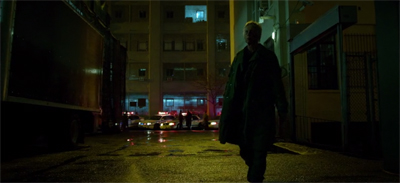
Although, if that is the best the NYPD can do, maybe Matt doesn’t really need to worry about “the end of vigilantes in New York.”
However, the second season of Daredevil does invite comparisons to other superhero sequels. During its second act, the second season of Daredevil feels a lot like The Wolverine; a clear three act structure without a clear antagonist for most of the runtime, complete with a surprisingly sweet central love story and hordes of anonymous ninjas. However, the jumbled and disjointed nature of its final act feels lot like Iron Man II. It feels like there is a weird little superhero movie buried somewhere in here, beneath the demands of the shared universe.
A Cold Day in Hell’s Kitchen is a disjointed and uneven resolution to a disjointed and uneven season.
You might be interested in our other reviews of the second season of Daredevil:
- Bang
- Dogs to a Gunfight
- New York’s Finest
- Penny and Dime
- Kinbaku
- Regrets Only
- Semper Fidelis
- Guilty as Sin
- Seven Minutes in Heaven
- The Man in the Box
- .380
- The Dark at the End of the Tunnel
- A Cold Day in Hell’s Kitchen
Filed under: Television | Tagged: daredevil, elektra, iron man ii, marvel, netflix, sequels, the hand |




















You’re right, this finale was seriously underwhelming and you could see the writers’ checklist at work. The rooftop fight would have been average in Arrow and is a big disappointment after earlier fights. Still, though noting the same flaws you have indicated, I very much enjoyed DD2 and hope the producers have time to shoehorn in S3 before the Defenders, especially as it seems Kingpin has worked out who DD is.
I am curious what the schedule is. It actually seems – my own misgivings aside – that S2 was an even greater success than S1. So I wouldn’t be surprising to see Spring become “Daredevil time” at Netflix. I just hope the third season has a stronger central story. Although, if they are doing Born Again, it’ll help to have stronger source material. (After all, Miller’s Kingpin stories were always more engaging than his Hand stories, even if the visuals were more dynamic with ninjas.)
I’m not even sure how Karen (or the police) are supposed to be able to see enough of the roof from that angle to comment on the action. Clearly no one noticed Nobu falling off, or spotted Stick ganking him in the alley, or even made a token gesture toward capturing the Punisher.
The season seemed to be building up to some big reveal concerning the sarcophagus and the blood draining and the bottomless hole in the ground, and then it turned into a fight with like 20 ninjas on a roof. (Not an “army”, not the hopeless battle Daredevil expected, just 20 ninjas on a roof). I mean, what was the deal with the hole?
I believe the hole was where they found the sarcophagus, but I don’t believe it was ever mentioned in dialogue and I wouldn’t bet on it actually being the case. Even if it is the case, who buries a Japanese (or Chinese, I think, based on the markings) sarcophagus in ancient New York City? Surely real estate in New Jersey was more affordable?